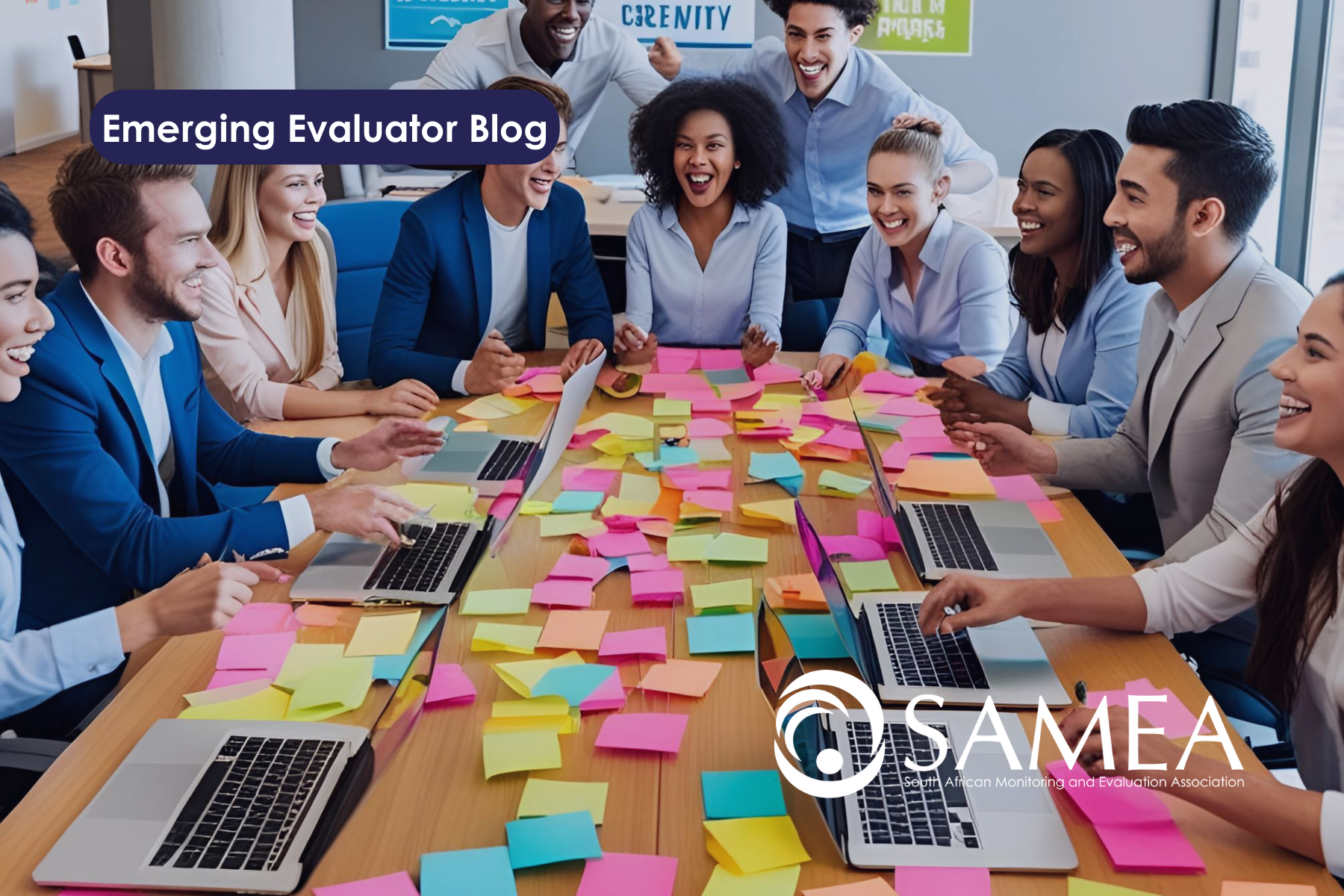Guidelines for Meaningfully Engaging Youth and Young Emerging Evaluators (YEEs) in Evaluations

Blog by Natefo Mothupi – Emerging Evaluator at SAMEA (2024)
Monitoring and Evaluation (M&E) is fundamental for effective decision-making, accountability, and learning. However, in Africa, a shortage of skilled evaluators hampers the ability to fully harness M&E for development initiatives (Matlala, 2024; UNFPA, 2023).
Addressing this gap requires innovative solutions, including expanding opportunities for youth and Young Emerging Evaluators (YEEs). The South African Monitoring and Evaluation Association (SAMEA) has been at the forefront of this effort, particularly through its YEE Programme.
Shifting the Paradigm: Youth and YEE Participation
SAMEA coined the term Young Emerging Evaluators to focus on capacitating youth within M&E. Through mentorship, competency-based training, and real-world evaluation opportunities, the YEE Programme aims to elevate youth from passive participants to co-creators in evaluation processes (Matlala, 2024; Ngwabi et al., 2020).
This participatory approach enriches evaluations by grounding them in the realities of youth experiences and fostering more inclusive, credible practices (Eval4Action, 2024).
Barriers to Youth and YEE Involvement
Several barriers hinder meaningful youth engagement, including:
-
Tokenistic engagement, where youth are relegated to peripheral roles (Matlala, 2024)
-
Lack of structured mentorship and capacity building (EvalForward, 2022)
-
Organisational resistance to shifting power dynamics (Ngwabi et al., 2020)
These barriers undermine innovation and perpetuate exclusion in M&E.
Addressing Barriers and Enhancing Participation
Key strategies to enhance youth involvement include:
-
Capacity Building: Integrating technical and soft skills development (Matlala, 2024)
-
Mentorship and Support: Bridging the gap between theory and practice (Eval4Action, 2024)
-
Participatory Approaches: Engaging youth as equal partners (CDA, 2023)
-
Organisational Commitment: Institutionalising youth engagement policies (UNFPA, 2023)
SAMEA’s Contributions
SAMEA’s YEE Programme rests on three pillars:
-
Mentorship
-
Capacity Building
-
Advocacy
Through competency frameworks, participatory tools, and leadership in the YEE strand, SAMEA continues to bridge the gap between academia and professional practice.
Existing Guidelines to Date
Several frameworks globally and regionally have contributed to shaping youth engagement approaches:
| Guideline/Framework | Region | Year | Sector | Key Points |
|---|---|---|---|---|
| Matlala’s Emerging Evaluator Article | South Africa | 2024 | Academic | Clear role definition and structured mentorship critical for empowerment |
| Khulisa Youth Inclusion Framework | South Africa | 2024 | Private | Sector-specific adaptation of youth engagement strategies |
| Eval4Action Standards | Global | 2024 | Civil Society | Young people as transformative agents in evaluations |
| HFRP Youth Research Projects | United States | 2002 | Civil Society | Youth participation promotes personal and community growth |
| CDA Youth Engagement Guide | Global | 2023 | Private | Links adolescent development science to evaluation practices |
| UNFPA Youth Engagement Guide | Global | 2024 | Public | Centres youth realities in all evaluation phases |
SAMEA Guideline
Based on regional experience and stakeholder workshops, SAMEA proposes the following guideline structured across the evaluation process:
Phase 1: Inception and Design
-
Engage YEEs in stakeholder meetings
-
Establish mentorship programmes
-
Conduct skill development workshops
Key Considerations: Create an inclusive, supportive environment and ensure accessible training.
Phase 2: Data Collection and Analysis
-
Provide field training opportunities
-
Promote collaboration during fieldwork
-
Involve YEEs in data analysis processes
Key Considerations: Ensure ongoing feedback, mentorship, and access to analysis tools.
Phase 3: Reporting and Dissemination
-
Involve YEEs in co-authoring reports
-
Develop presentation skills
-
Leverage media and digital platforms for dissemination
Key Considerations: Recognise contributions and promote professional growth.
Youth as Evaluands
Phase 1: Inception and Design
-
Involve youth in tool development
-
Pre-evaluation engagement to build trust
Key Considerations: Ensure tools are youth-friendly and culturally sensitive.
Phase 2: Data Collection and Analysis
-
Use participatory methods (e.g., focus groups, storytelling)
-
Employ anonymous feedback mechanisms
-
Involve youth in validating findings
Key Considerations: Address barriers like digital divides and language gaps.
Phase 3: Reporting and Dissemination
-
Develop youth-centric summaries
-
Host sense-making workshops
-
Disseminate findings through digital channels
Key Considerations: Clearly demonstrate how youth contributions shaped recommendations.
Limitations of the Guidelines
Challenges include:
-
Resource Intensiveness: High costs of full implementation
-
Institutional Rigidity: Bureaucratic hurdles in government sectors
-
Mentorship Gaps: Lack of experienced mentors
-
Scalability Issues: Variations in organisational capacities
-
Sustainability Challenges: Maintaining youth engagement post-project
Conclusion
These guidelines offer a comprehensive framework for meaningfully involving youth and YEEs in evaluations. However, successful implementation demands sustained organisational commitment, flexible approaches tailored to local contexts, and a willingness to address systemic barriers.
SAMEA’s leadership positions it well to drive these changes, setting a new benchmark for equity-driven, youth-centred evaluation practices across Africa.
Most Recent Read
Discover more topics
